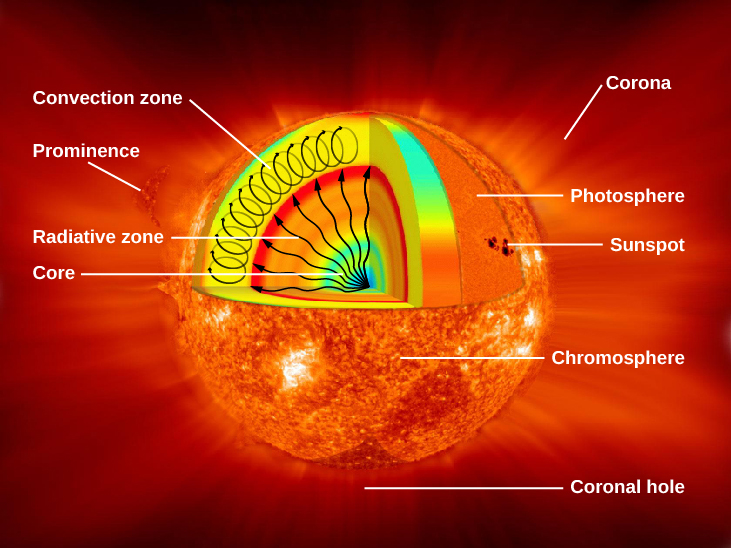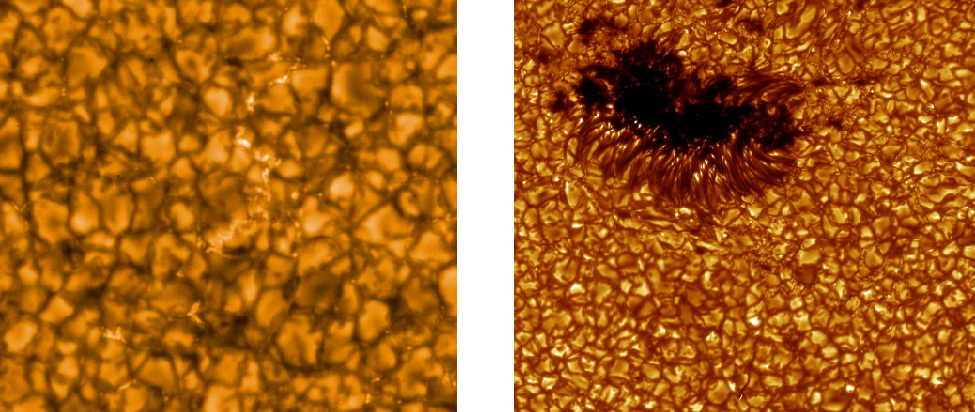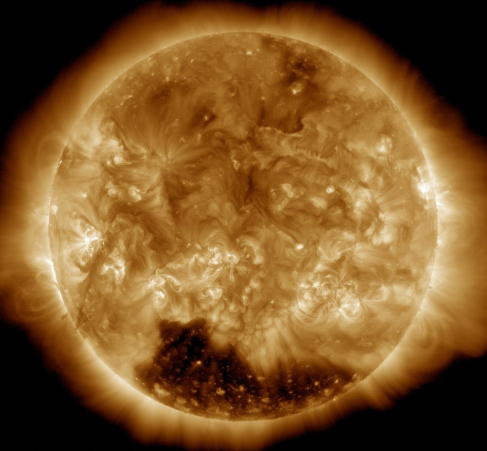10.3 Anatomy of the Sun
Let’s begin by asking what the solar atmosphere is made of. We can use a star’s absorption line spectrum to determine what elements are present. It turns out that the Sun contains the same elements as Earth but not in the same proportions. About 73% of the Sun’s mass is hydrogen, and another 25% is helium. All the other chemical elements (including those we know and love in our own bodies, such as carbon, oxygen, and nitrogen) make up only 2% of our star. The 10 most abundant gases in the Sun’s visible surface layer are listed in Table 10.2. Examine that table and notice that the composition of the Sun’s outer layer is very different from Earth’s crust, where we live. (In our planet’s crust, the three most abundant elements are oxygen, silicon, and aluminum.) Although not like our planet’s, the makeup of the Sun is quite typical of stars in general.
| Element | Percentage by Number of Atoms | Percentage By Mass |
|---|---|---|
| Hydrogen | 92.0 | 73.4 |
| Helium | 7.8 | 25.0 |
| Carbon | 0.02 | 0.20 |
| Nitrogen | 0.008 | 0.09 |
| Oxygen | 0.06 | 0.80 |
| Neon | 0.01 | 0.16 |
| Magnesium | 0.003 | 0.06 |
| Silicon | 0.004 | 0.09 |
| Sulfur | 0.002 | 0.05 |
| Iron | 0.003 | 0.14 |
The fact that our Sun and the stars all have similar compositions and are made up of mostly hydrogen and helium was first shown in a brilliant thesis in 1925 by Cecilia Payne-Gaposchkin, the first woman to get a PhD in astronomy in the United States, pictured in Figure 10.6. However, the idea that the simplest light gases—hydrogen and helium—were the most abundant elements in stars was so unexpected and so shocking that she assumed her analysis of the data must be wrong. At the time, she wrote, “The enormous abundance derived for these elements in the stellar atmosphere is almost certainly not real.” Even scientists sometimes find it hard to accept new ideas that do not agree with what everyone “knows” to be right.
Cecilia Payne-Gaposchkin (1900–1979)

Cecilia Helena Payne Gaposchkin (1900-1979) by Smithsonian Institution Archives, Public Domain.
Before Payne-Gaposchkin’s work, everyone assumed that the composition of the Sun and stars would be much like that of Earth. It was 3 years after her thesis that other studies proved beyond a doubt that the enormous abundance of hydrogen and helium in the Sun is indeed real. (And, as we will see, the composition of the Sun and the stars is much more typical of the makeup of the universe than the odd concentration of heavier elements that characterizes our planet.)
Most of the elements found in the Sun are in the form of atoms, with a small number of molecules, all in the form of gases: the Sun is so hot that no matter can survive as a liquid or a solid. In fact, the Sun is so hot that many of the atoms in it are ionized, that is, stripped of one or more of their electrons. This removal of electrons from their atoms means that there is a large quantity of free electrons and positively charged ions in the Sun, making it an electrically charged environment—quite different from the neutral one in which you are reading this text. (Scientists call such a hot ionized gas a plasma.)
In the nineteenth century, scientists observed a spectral line at 530.3 nanometres in the Sun’s outer atmosphere, called the corona (a layer we will discuss in a minute.) This line had never been seen before, and so it was assumed that this line was the result of a new element found in the corona, quickly named coronium. It was not until 60 years later that astronomers discovered that this emission was in fact due to highly ionized iron—iron with 13 of its electrons stripped off. This is how we first discovered that the Sun’s atmosphere had a temperature of more than a million degrees.
Figure 10.7 shows what the Sun would look like if we could see all parts of it from the centre to its outer atmosphere; the terms in the figure will become familiar to you as you read on.
Parts of the Sun

The Sun by NASA/Goddard, NASA Media License.
The Sun’s layers are different from each other, and each plays a part in producing the energy that the Sun ultimately emits. We will begin with the core and work our way out through the layers. The Sun’s core is extremely dense and is the source of all of its energy. Inside the core, nuclear energy is being released. The core is approximately 20% of the size of the solar interior and is thought to have a temperature of approximately 15 million K, making it the hottest part of the Sun.
Above the core is a region known as the radiative zone—named for the primary mode of transporting energy across it. This region starts at about 25% of the distance to the solar surface and extends up to about 70% of the way to the surface. The light generated in the core is transported through the radiative zone very slowly, since the high density of matter in this region means a photon cannot travel too far without encountering a particle, causing it to change direction and lose some energy.
The convective zone is the outermost layer of the solar interior. It is a thick layer approximately 200,000 kilometres deep that transports energy from the edge of the radiative zone to the surface through giant convection cells, similar to a pot of boiling oatmeal. The plasma at the bottom of the convective zone is extremely hot, and it bubbles to the surface where it loses its heat to space. Once the plasma cools, it sinks back to the bottom of the convective zone.
Now that we have given a quick overview of the structure of the whole Sun, in this section, we will embark on a journey through the visible layers of the Sun, beginning with the photosphere—the visible surface.
Earth’s air is generally transparent. But on a smoggy day in many cities, it can become opaque, which prevents us from seeing through it past a certain point. Something similar happens in the Sun. Its outer atmosphere is transparent, allowing us to look a short distance through it. But when we try to look through the atmosphere deeper into the Sun, our view is blocked. The photosphere is the layer where the Sun becomes opaque and marks the boundary past which we cannot see.
Solar Photosphere plus Sunspots

Modification of work by NASA/SDO, NASA Media License
NASA put together a static image and a video of the Sun’s atmosphere in different wavelengths. Static image can be found at https://www.nasa.gov/content/goddard/sdo/wheel-of-colourful-sun-sdo5/
As we saw, the energy that emerges from the photosphere was originally generated deep inside the Sun. This energy is in the form of photons, which make their way slowly toward the solar surface. Outside the Sun, we can observe only those photons that are emitted into the solar photosphere, where the density of atoms is sufficiently low and the photons can finally escape from the Sun without colliding with another atom or ion.
As an analogy, imagine that you are attending a big campus rally and have found a prime spot near the centre of the action. Your friend arrives late and calls you on your cell phone to ask you to join her at the edge of the crowd. You decide that friendship is worth more than a prime spot, and so you work your way out through the dense crowd to meet her. You can move only a short distance before bumping into someone, changing direction, and trying again, making your way slowly to the outside edge of the crowd. All this while, your efforts are not visible to your waiting friend at the edge. Your friend can’t see you until you get very close to the edge because of all the bodies in the way. So too photons making their way through the Sun are constantly bumping into atoms, changing direction, working their way slowly outward, and becoming visible only when they reach the atmosphere of the Sun where the density of atoms is too low to block their outward progress.
Astronomers have found that the solar atmosphere changes from almost perfectly transparent to almost completely opaque in a distance of just over 400 kilometres; it is this thin region that we call the photosphere, a word that comes from the Greek for “light sphere.” When astronomers speak of the “diameter” of the Sun, they mean the size of the region surrounded by the photosphere.
The photosphere looks sharp only from a distance. If you were falling into the Sun, you would not feel any surface but would just sense a gradual increase in the density of the gas surrounding you. It is much the same as falling through a cloud while skydiving. From far away, the cloud looks as if it has a sharp surface, but you do not feel a surface as you fall into it. (One big difference between these two scenarios, however, is temperature. The Sun is so hot that you would be vaporized long before you reached the photosphere. Skydiving in Earth’s atmosphere is much safer.)
We might note that the atmosphere of the Sun is not a very dense layer compared to the air in the room where you are reading this text. At a typical point in the photosphere, the pressure is less than 10% of Earth’s pressure at sea level, and the density is about one ten-thousandth of Earth’s atmospheric density at sea level.
Observations with telescopes show that the photosphere has a mottled appearance, resembling grains of rice spilled on a dark tablecloth or a pot of boiling oatmeal. This structure of the photosphere is called granulation, it is shown in Figure 10.9. Granules, which are typically 700 to 1000 kilometres in diameter (about the width of Texas), appear as bright areas surrounded by narrow, darker (cooler) regions. The lifetime of an individual granule is only 5 to 10 minutes. Even larger are supergranules, which are about 35,000 kilometres across (about the size of two Earths) and last about 24 hours.
Granulation Pattern

Credit left: Hinode Views the Sun’s Surface by Hinode JAXA/NASA/PPARC , NASA Media License
Credit right: ISP/SST/Oddbjorn Engvold, Jun Elin Wiik, Luc Rouppe van der Voort, Public Domain (Replace with alternative we can credit properly)
The motions of the granules can be studied by examining the Doppler shifts in the spectra of gases just above them. The bright granules are columns of hotter gases rising at speeds of 2 to 3 kilometres per second from below the photosphere. As this rising gas reaches the photosphere, it spreads out, cools, and sinks down again into the darker regions between the granules. Measurements show that the centres of the granules are hotter than the intergranular regions by 50 to 100 K.
The Sun’s outer gases extend far beyond the photosphere as shown in Figure 10.10. Because they are transparent to most visible radiation and emit only a small amount of light, these outer layers are difficult to observe. The region of the Sun’s atmosphere that lies immediately above the photosphere is called the chromosphere. Until this century, the chromosphere was visible only when the photosphere was concealed by the Moon during a total solar eclipse. In the seventeenth century, several observers described what appeared to them as a narrow red “streak” or “fringe” around the edge of the Moon during a brief instant after the Sun’s photosphere had been covered. The name chromosphere, from the Greek for “coloured sphere,” was given to this red streak.
Observations made during eclipses show that the chromosphere is about 2000 to 3000 kilometres thick, and its spectrum consists of bright emission lines, indicating that this layer is composed of hot gases emitting light at discrete wavelengths. The reddish colour of the chromosphere arises from one of the strongest emission lines in the visible part of its spectrum—the bright red line caused by hydrogen, the element that, as we have already seen, dominates the composition of the Sun.
In 1868, observations of the chromospheric spectrum revealed a yellow emission line that did not correspond to any previously known element on Earth. Scientists quickly realized they had found a new element and named it helium (after helios, the Greek word for “Sun”). It took until 1895 for helium to be discovered on our planet. Today, students are probably most familiar with it as the light gas used to inflate balloons, although it turns out to be the second-most abundant element in the universe.
The temperature of the chromosphere is about 10,000 K. This means that the chromosphere is hotter than the photosphere, which should seem surprising. In all the situations we are familiar with, temperatures fall as one moves away from the source of heat, and the chromosphere is farther from the centre of the Sun than the photosphere is.
The outermost part of the Sun’s atmosphere is called the corona. Like the chromosphere, the corona was first observed during total eclipses. Unlike the chromosphere, the corona has been known for many centuries: it was referred to by the Roman historian Plutarch and was discussed in some detail by Kepler.
The corona extends millions of kilometres above the photosphere and emits about half as much light as the full moon. The reason we don’t see this light until an eclipse occurs is the overpowering brilliance of the photosphere. Just as bright city lights make it difficult to see faint starlight, so too does the intense light from the photosphere hide the faint light from the corona. While the best time to see the corona from Earth is during a total solar eclipse, it can be observed easily from orbiting spacecraft. Its brighter parts can now be photographed with a special instrument—a coronagraph—that removes the Sun’s glare from the image with an occulting disk (a circular piece of material held so it is just in front of the Sun).
Coronagraph

A moment in the sun’s atmosphere by NASA/SOHO, NASA Media License
Studies of its spectrum show the corona to be very low in density. At the bottom of the corona, there are only about 109 atoms per cubic centimetre, compared with about 1016 atoms per cubic centimetre in the upper photosphere and 1019 molecules per cubic centimetre at sea level in Earth’s atmosphere. The corona thins out very rapidly at greater heights, where it corresponds to a high vacuum by Earth laboratory standards. The corona extends so far into space—far past Earth—that here on our planet, we are technically living in the Sun’s atmosphere.
One of the most remarkable discoveries about the Sun’s atmosphere is that it produces a stream of charged particles (mainly protons and electrons) that we call the solar wind. These particles flow outward from the Sun into the solar system at a speed of about 400 kilometres per second (almost 1 million miles per hour)! The solar wind exists because the gases in the corona are so hot and moving so rapidly that they cannot be held back by solar gravity. (This wind was actually discovered by its effects on the charged tails of comets; in a sense, we can see the comet tails blow in the solar breeze the way wind socks at an airport or curtains in an open window flutter on Earth.)
Although the solar wind material is very, very rarified (i.e., extremely low density), the Sun has an enormous surface area. Astronomers estimate that the Sun is losing about 10 million tons of material each year through this wind. While this amount of lost mass seems large by Earth standards, it is completely insignificant for the Sun.
From where in the Sun does the solar wind emerge? In visible photographs, the solar corona appears fairly uniform and smooth. X-ray and extreme ultraviolet pictures, however, show that the corona has loops, plumes, and both bright and dark regions. Large dark regions of the corona that are relatively cool and quiet are called coronal holes, shown in Figure 10.12. In these regions, magnetic field lines stretch far out into space away from the Sun, rather than looping back to the surface. The solar wind comes predominantly from coronal holes, where gas can stream away from the Sun into space unhindered by magnetic fields. Hot coronal gas, on the other hand, is present mainly where magnetic fields have trapped and concentrated it.
Coronal Hole

Solar Dynamics Observatory Welcomes the New Year by NASA/SDO, NASA Media License
At the surface of Earth, we are protected to some degree from the solar wind by our atmosphere and Earth’s magnetic field. However, the magnetic field lines come into Earth at the north and south magnetic poles. Here, charged particles accelerated by the solar wind can follow the field down into our atmosphere. As the particles strike molecules of air, they cause them to glow, producing beautiful curtains of light called the auroras, or the northern and southern lights as shown in Figure 10.13.
Aurora

Aurora Borealis by Moyan Brenn, CC BY 4.0
Attribution
“15.1 The Structure and Composition of the Sun ” from Douglas College Astronomy 1105 by Douglas College Department of Physics and Astronomy, is licensed under a Creative Commons Attribution 4.0 International License, except where otherwise noted. Adapted from Astronomy 2e.


